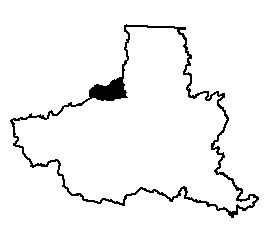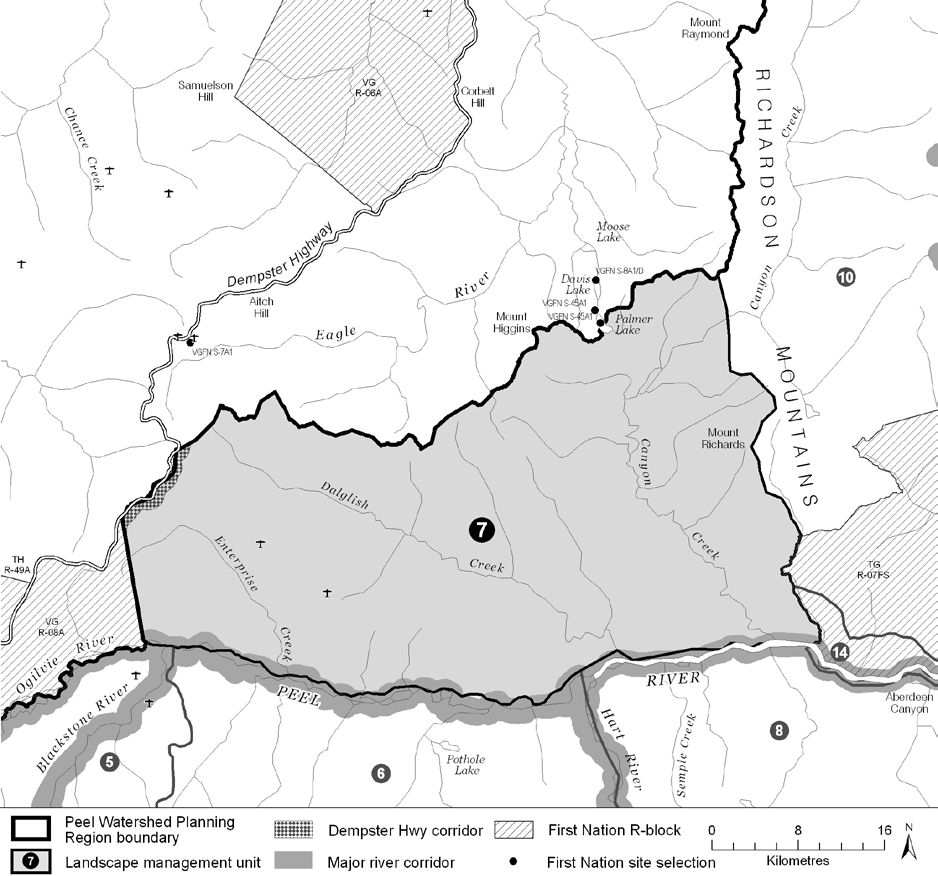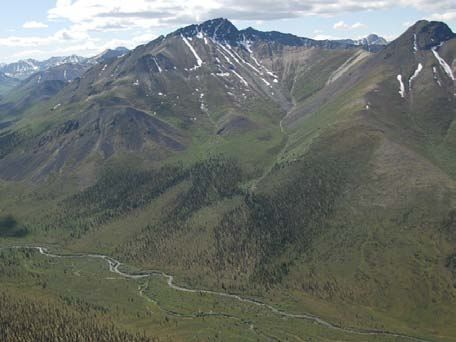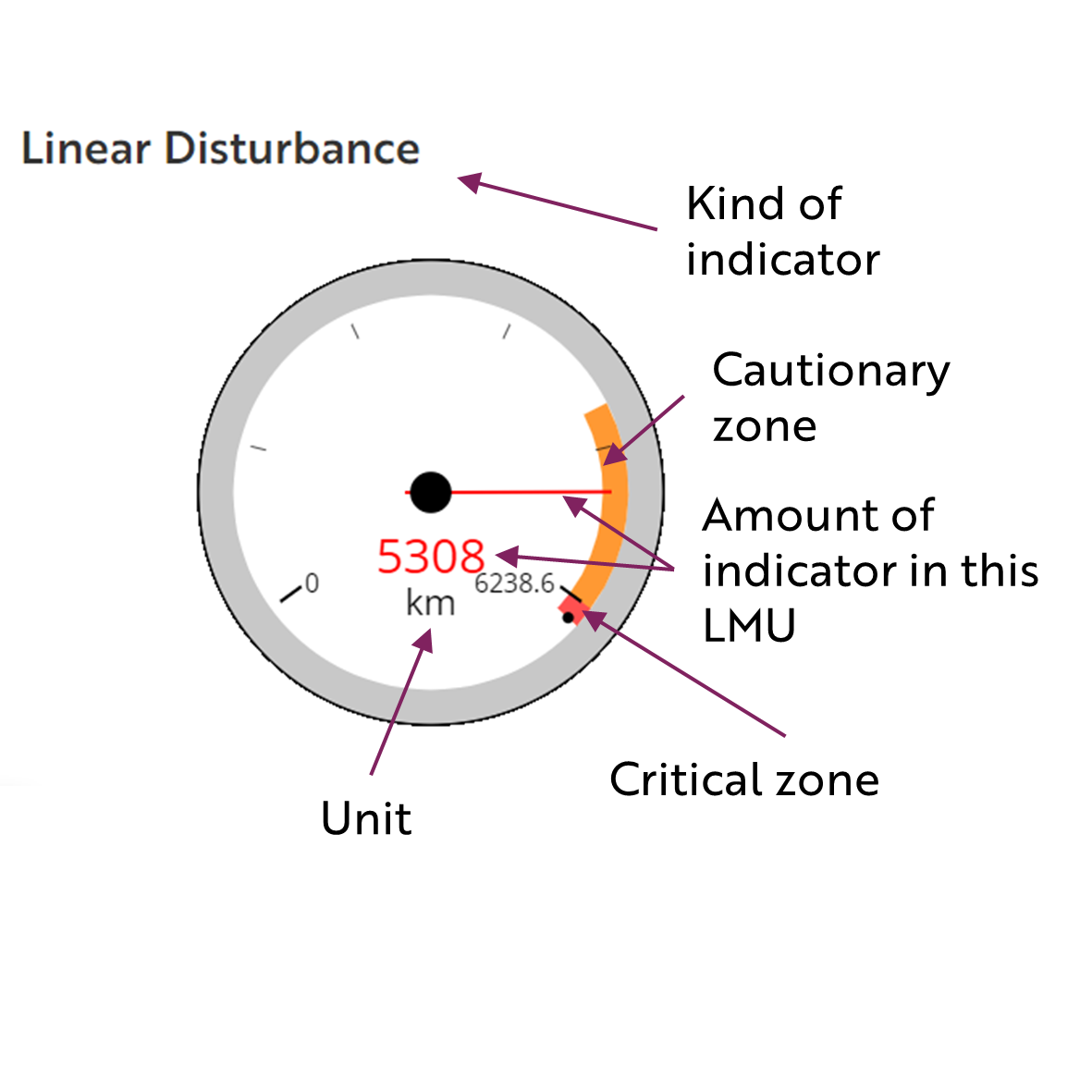PEEL WATERSHED PLANNING REGION:
LMU 7: Dalglish Creek
Land Use Designation
Integrated Management Area, Zone IV
Land Status
Non-Settlement Land
Traditional Territories
Tr’ondëk Hwëch’in, Na-Cho Nyäk Dun, Vuntut Gwitchin, Tetłit Gwich’in Primary and Secondary Use Area
Area
1,554 km2 (2% of Region)


Objectives
- Ecological integrity is maintained.
- Some culturally and ecologically-aware resource exploration and extraction that supports the local economies.
- All permitted land use activity does not significantly impact movement and habitats of caribou.
- Industrial activity does not result in any alteration to the Peel River’s viewscape.
Rationale for Designation
- Adjacency to the Dempster Highway may allow development to occur more readily with less access-
related impacts. - Highest oil and gas development potential in the Region.
- No big-game outfitting activities and no tourism/recreation activities beyond the Peel River corridor.
- Porcupine caribou use the entire unit, though only the extreme SW corner falls in a concentrated winter use area. The biggest value of this unit for this herd likely is as a migration route. This calls for some limitations on industrial development; however,
- Development will likely occur on relatively flat terrain, making the recommended cumulative effects monitoring more effective in limiting impacts on habitat in those area, thus meriting a Zone IV designation.
Cumulative Effects Thresholds
Relative to LMU Size*
Surface Disturbance (%)
Linear Density (km/km2)
Current disturbance (2020)
0.2825
0.3183
Cautionary
0.750
0.750
Critical
1.000
1.000
On the ground amounts**
Surface Disturbance (km2)
Linear Disturbance (km)
Current disturbance (2020)
4.39
494.7
Room under cautionary threshold***
7.27
671.1
Cautionary
11.66
1165.7
Critical
15.54
1554.3
*These are proportional to the size of the LMU, and correspond to table 3-2 of the Approved Plan. They are measured in the % of the LMU that can be disturbed (“Surface Disturbance”) and in km/km2 (“Linear Disturbance Density”).
**These are amounts that can be measured and apply to the whole LMU and would be more familiar to project proponents and regulators. They are measured in km2 of disturbance and in km of linear disturbance (e.g., roads, trails and cutlines).
***How much more disturbance can be added to existing disturbance before the cautionary threshold is reached.
Surface Disturbance
Linear Disturbance
Cautionary
Critical
Biophysical Setting
Setting
Rolling forested plateau with incised creeks north of the Peel River and west of the Richardson Mountains
Ecoregions
Eagle Plains
Bioclimatic Zones
Taiga Wooded
Image Explanation
LMU 7 is characterized by rolling forested (front left) or recently burned (centre) terrain. A historic winter road (circa 1950s) to Eagle Plains is visible in this photo. (CWS photo)

Ecological Resources
Caribou
Moderate habitat suitability for the Porcupine herd, and includes general use areas for the fall migration, rutting, and winter seasons. Importance to the migration of the Porcupine herd may increase as development occurs to the north.
Moose
Generally low late winter habitat quality, though ribbons of high value habitat follow major creeks.
Marten
Variable winter habitat value, though generally moderate or high.
Sheep
Virtually no sheep habitat.
Fish
Fish likely present throughout unit.
Grizzly Bear
Moderate to high habitat suitability.
Peregrine Falcon
Some peregrine foraging habitat along Peel River.
Birds (General)
High value waterbird habitat along riparian areas; variable breeding spp. richness and moderate species of conservation concern (high pockets).
Vegetation
Low endemism/rarity. Low-mid elev. wet/dry herb and shrub, and dry coniferous forest.
Wetlands, Lakes and Riparian Areas
Wetlands along Peel River and a few scattered wetlands within unit.
Permafrost
Continuous permafrost is predicted.
Special Features
Wildlife passes, Canyon Creek Canyon.
Heritage, Social and Cultural Resources
Heritage Resources
TG and TH travel routes along Dalglish and Canyon Creeks to Peel River; many VG and TG archaeological sites; TG culturally important places.
Palaeontological Resources
The Eagle Plains and sandstone sedimentary rocks have known fossil localities and this area (including Canyon Creek) has high potential to yield further discoveries
Economic Development
Transportation and Access
Adjacent to a short section of the Dempster Highway. Few old unclassified linear features and historic trail to Eagle Plains via the Wind River; a conceptual access route has been identified in this unit; two airstrips. Adjacent to floatplane landing on the Peel River at Canyon Creek.
Traditional Economy
TG seasonal land use and traditional harvesting and wildlife areas.
Recreation and Tourism
Little current tourism beyond some paddling along the Peel River, though the canyon on Canyon Creek has very high tourism potential.
Forestry
Little potential for forestry.
Big Game Outfitters and Trapping
No registered concessions.
Oil and Gas Resources
Eagle plains basin; highest potential in the PWPR; three abandoned wells, one capped well. Oil and gas permit (#0014 & #0015) and Significant Discovery Licenses (SDL-020 & SDL-021).
Mineral Resources
Approximately 140 quartz claims (2023); generally low mineral potential.
Special Management Considerations
- The proposed right-of-way for the Dempster Highway lateral pipeline runs along western boundary.
- Major River Corridor management directions apply along the Peel River.
- Dempster Corridor management directions apply near the Dempster Highway.
- Subsequent Dempster Highway land use plan may apply near the Dempster Highway.
- Much of the unit was affected by fire in the summer of 2005.
These gauges show how much of each disturbance indicator there is in the LMU with the needle and the large number near the middle. The colours indicate disturbance level zones or thresholds. If the needle is in the white zone, no threshold has been reached.
The Dawson Planning Commission gives a details of their similar (but slightly different) Cumulative Effects Framework on their website.

Cautionary
Critical
